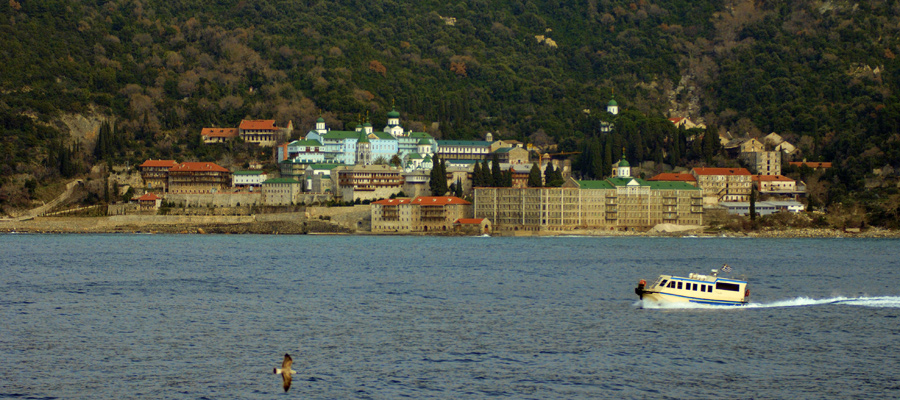Panteleimonos monastery
The large building complex known as the “Russian” is located north of Daphne, in the northwestern side of Athos. It originated in the 12th century, by the merging of two byzantine monasteries, the Theotokos of Xilourgou and St. Panteleimonos. Russian monks inhabited the Xilourgou monastery located where the skete of Virgin Mary is today, in the 11th century. Panteleimonos monastery, today’s “Palaiomonastirio”, was deserted in 1169 when Russian hermits occupied it. It was then, that the Ros (Russians in the middle ages) were given permission by the “First” of Athos to renovate and fortify the monastery. It prospered under the protection of Serbian rulers after it had been burnt down in the 13th century.
The monastery as it is today, was built in 1765 with the support of the Phanariot family of Callimachs, rulers of Wallachia. The first Russian monks arrived in 1835, after many years of absence, and the first Russian abbot was elected in 1875. Large donations by the Tsar family gave great prestige and power to the monastery, and in the early 20th century it housed more than 1.000 monks and 1.000 workers, professionals and visitors. The riot that broke from the sect of “onomatolatria” (veneration of the name of Jesus as used in the Jesus prayer) sent many to exile, while the October Revolution halted the arrival of new monks.
The roof of the Catholicon has eight bulb-formed, Russian style domes. It honors the name of St. Panteleimonas and according to the inscription Scarlatos Callimachis built it between 1812 and 1821. It combines Athonite type and Russian temple construction elements. The church services are chanted alternately in Greek and Russian language by a sigillium. The monastery has 35 chapels. The independent building of the Altar, built in 1893 is opposite of the entrance of the Catholicon. Its size is impressive since it can cater 1.000 people. The large bell that is said to be heard as far as Sporades, located in the bell tower is equally admirable. It has a circumference of 8,71m, a diameter of 2,71m and weighs 13.000kg.
Text: Dr. Antonios G. Dikaios/ Theologian – Environmentalist.






